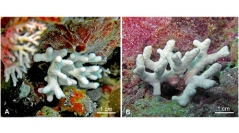

 European Journal of Taxonomy
773 (1) - Pages 1-18
European Journal of Taxonomy
773 (1) - Pages 1-18The taxonomy of cyclostome bryozoans is founded on characters of the skeleton, but molecular sequence data have increasingly shown that established higher taxa are not monophyletic. Here we describe the skeletal morphology of a new species from Guadeloupe (French West Indies) with erect ramose colonies consisting of long, curved zooids that are typical of the suborder Cerioporina among living cyclostomes. However, molecular evidence from nuclear ribosomal RNA genes 18S and 28S places the new taxon in the suborder Rectangulata, where this colony-form has not been previously recorded. It nests firmly within the genus Disporella Gray, 1848, in a strongly supported clade that also includes Plagioecia patina (Lamarck, 1816) (Tubuliporina) and the sister taxa Doliocoitis cyanea Gordon & Taylor, 2001 (Rectangulata) and Favosipora rosea Gordon & Taylor, 2001 (Cerioporina). The short and robust branches of the new Guadeloupe cyclostome, here named Disporella guada Harmelin, Taylor & Waeschenbach sp. nov., are well adapted to life in shallow rocky sites exposed to severe wave action, which appear to be its exclusive habitat.
Lichenoporidae, growth-form, taxonomy, molecular phylogeny, evolution